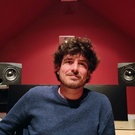
Alberto Maria Gatti
Alberto Maria Gatti (1992) est compositeur, RIM et sound designer. Il s'intéresse principalement à la musique électroacoustique, allant de la musique acousmatique au théâtre musical. Depuis 2018, il explore la relation entre le corps et le son, en utilisant des transducteurs vibrants pour transformer les objets et les corps en diffuseurs acoustiques. Il a participé à des festivals de musique contemporaine et à des événements dans des institutions telles que l'Ircam (Journée Portes Ouvertes 2023), la Biennale de Berlin, Inner Spaces, Tempo Reale, Museo Pecci, Milano Books, Milano Musica, Fabbrica Europa, Teatro dell'Opera di Roma, Forum Wallis et d'autres. Il a étudié la musique électronique au conservatoire de Florence avec Marco Ligabue et Simone Conforti et a obtenu le master AReMus au conservatoire de Rome. Il a ensuite étudié la composition et la direction sonore avec Tiziano Manca, Vittorio Montalti, Alvise Vidolin et Roberto Castello. Depuis 2021, il est sound designer au sein de la société Musi-co. Il est actuellement compositeur indépendant et enseigne à l'école de musique de Fiesole et au conservatoire G. Puccini de La Spezia.
![]()
Résidence en recherche artistique 2023.24
RE-SOUNDING BODIES
Thématique de la recherche :
Concevoir un modèle expérimental d'un environnement intelligent en temps réel destiné à un dispositif audio-tactile spécialisé dans la spatialisation et la reproduction fidèle du son
Domaine de recherche :
Composer avec des vibrations audio-tactiles
En collaboration avec les équipes Perception et design sonores et Interaction Son Musique mouvement de l'Ircam-STMS.
L'utilisation de transducteurs vibrants a vu divers types d'applications ces dernières années, allant à la fois du domaine électroacoustique au domaine strictement artistique. En particulier, la conduction osseuse du son a connu un grand développement, attirant l'attention sur une nouvelle idée de la perception sonore. Le problème derrière cette pratique provient souvent d'une difficulté à organiser le contenu sonore à diffuser avec des transducteurs vibrants, souvent mal adaptés à une restitution sonore fidèle. Le but de ce projet est de créer un logiciel qui vise l'analyse en temps réel et l'adaptation automatique de contenus sonores sur des dispositifs impliquant un ou plusieurs transducteurs vibrants, résolvant ainsi également la gestion de la diffusion spatiale du son. À cette fin, le logiciel fournit également un système de contrôle du flux sonore avec l'utilisation de capteurs de mouvement appliqués aux utilisateurs ou aux interprètes éventuels. Le résultat du projet sera réalisé grâce à l'application d'un outil capable d'étudier la relation de perception musicale audio-tactile lors d'une performance en direct, exploitant un système hybride de transduction os-crânienne côte à côte avec un système multicanal traditionnel.


